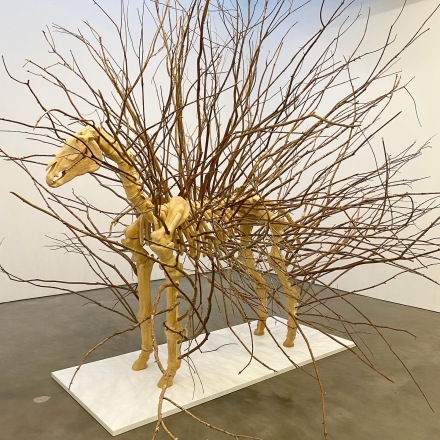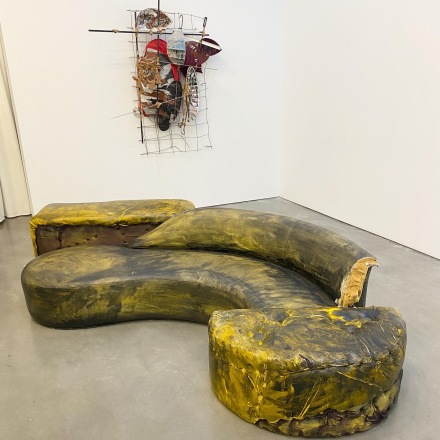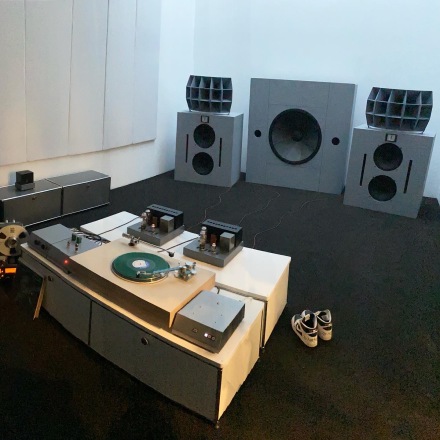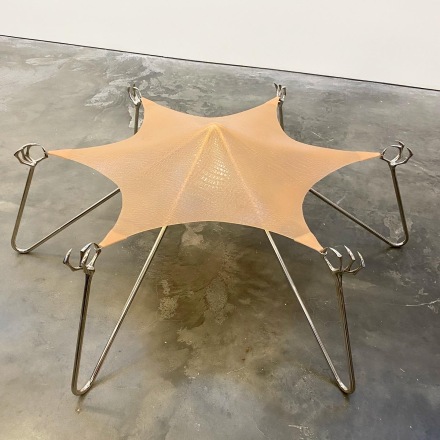
Hugh Hayden, all images via Art Observed
Lisson Gallery wades into summer group show month with The odds are good, the goods are odd this year, a group exhibition that highlights a new generation of New York-based sculptors. Bringing together artworks across a range of mediums, the presentation showcases the divergent ethoses behind sculpture-making today. The featured artists favor the handmade, creating a spectrum of artworks that range from the polished and conceptual, to the raw and visceral.
United through the use of atypical materials, the eleven artists in the exhibition inhabit a field outside of the sculptural norm and resist a trend-driven system. They opt, instead, to confront formality. The artists share an interest in the human body, its strength and its fragility, and the challenges of contemporary forces on it, seeking both solutions and a more visible approach to its problems and limitations.
A colossal equine by Hugh Hayden stands at the entrance of the gallery, continuing the artist’s exploration of layered meaning and significant associations with societal categorization: race, religion, ethnicity, etc. This is paralleled by work by Kristi Cavatoro, a pair of large stained-glass sculptures, one mounted to the wall and the other situated on the floor. The multifaceted structures, at once rounded and cubic, are the product of tedious mathematic calculations and hands-on construction, adapted from the technique of Louis Comfort Tiffany.

The odds are good, the goods are odd (Installation View)
Throughout, the show draws from a range of processes and practices, and the varied forces and the range of social undercurrents that backdrop them Eighteen glazed ceramic figures presented by Leilah Babirye examine LGBTQ+ history and confront the cultural traditions surrounding sexuality and human rights in the artist’s native Uganda while sculptures by Doreen Lynette Garner engage the body through a historical lens, examining past and present patterns of medically sanctioned racial violence, focusing on medical experimentation on Black women’s bodies in the US.
Other approaches towards the industrial come from artists like Kristin Walsh and Hannah Levy, each exhibiting taut aluminum and steel works, respectively, that underscore human interrelation with mechanical processes, and the capacity for new forms emerging from industrial processes. while artist Jessi Reaves renders a reverse process on humble materials often found or scavenged. Her sculpted forms, handmade and at times irrational, are never fully detached from function. In European Yellow Couch (2018), Reaves transforms the upholstered sofa, cutting, painting and rearranging to turn the figure inside out, revealing a new definitive structure. Reaves’ objects are a funhouse facsimile of their original design, questioning the purpose of construction and toying with perceptions of practicality and aesthetics.
Also of note is a listening room crafted by Devon Turnbull is also featured in the exhibition, a rare foray into the sculptural realm for the audio- and designed-inclined multidisciplinarian. Trained as an audio engineer, Turnbull, who also goes by the creative pen name OJAS, creates high efficacy speakers and low powered tube amplifiers by hand. Each sound sculpture is unique, and Turnbull meticulously sources rare audio parts to build his intricate, yet minimally-designed constructions. Throughout the run of the exhibition, the gallery will present week-long, focused programs in the listening room that feature rare music records and additional audio highlights.
In each, these artists emphasize new ways of living with new forms, and how these forms may in turn shape ways of living. The show closes August 5th.
– D. Creahan
Read more:
The odds are good, the goods are odd [Exhibition Site]





